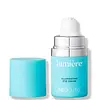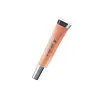What's inside
What's inside
 Key Ingredients
Key Ingredients

 Benefits
Benefits

 Concerns
Concerns

 Ingredients Side-by-side
Ingredients Side-by-side

Water
Skin ConditioningCaprylic/Capric Triglyceride
MaskingC12-20 Acid PEG-8 Ester
EmulsifyingGlycerin
HumectantButylene Glycol
HumectantCetyl Alcohol
EmollientPEG-8
HumectantSaccharide Isomerate
HumectantCaprylyl Glycol
EmollientPotassium Cetyl Phosphate
EmulsifyingCarbomer
Emulsion StabilisingBisabolol
MaskingTetrahexyldecyl Ascorbate
AntioxidantCaffeine
Skin ConditioningLecithin
EmollientCutaneous Lysate
MoisturisingGlycyrrhetinic Acid
Skin ConditioningSodium Hyaluronate
HumectantSodium Polyacrylate
AbsorbentCitric Acid
BufferingTocopherol
AntioxidantFagus Sylvatica Bud Extract
TonicElaeis Guineensis Oil
EmollientTocotrienols
Skin ConditioningAscorbyl Palmitate
AntioxidantSqualane
EmollientAscorbic Acid
AntioxidantPhytosterols
Skin ConditioningSodium Citrate
BufferingDisodium EDTA
Sodium Hydroxide
BufferingPhenoxyethanol
PreservativeMethylparaben
PreservativeEthylparaben
PreservativePropylparaben
PreservativeButylparaben
MaskingWater, Caprylic/Capric Triglyceride, C12-20 Acid PEG-8 Ester, Glycerin, Butylene Glycol, Cetyl Alcohol, PEG-8, Saccharide Isomerate, Caprylyl Glycol, Potassium Cetyl Phosphate, Carbomer, Bisabolol, Tetrahexyldecyl Ascorbate, Caffeine, Lecithin, Cutaneous Lysate, Glycyrrhetinic Acid, Sodium Hyaluronate, Sodium Polyacrylate, Citric Acid, Tocopherol, Fagus Sylvatica Bud Extract, Elaeis Guineensis Oil, Tocotrienols, Ascorbyl Palmitate, Squalane, Ascorbic Acid, Phytosterols, Sodium Citrate, Disodium EDTA, Sodium Hydroxide, Phenoxyethanol, Methylparaben, Ethylparaben, Propylparaben, Butylparaben
Water
Skin ConditioningCyclopentasiloxane
EmollientIsododecane
EmollientPhenyl Trimethicone
Skin ConditioningMethylpropanediol
SolventGlycerin
HumectantPortulaca Oleracea Extract
Skin ConditioningAloe Barbadensis Leaf Juice
Skin ConditioningCaprylic/Capric Triglyceride
MaskingDimethicone
EmollientLauryl PEG-10 Tris(Trimethylsiloxy)Silylethyl Dimethicone
EmulsifyingPEG-10 Dimethicone
Skin ConditioningPropylene Glycol Dicaprylate/Dicaprate
EmollientPolymethyl Methacrylate
Sodium Chloride
MaskingCetyl PEG/PPG-10/1 Dimethicone
EmulsifyingTrimethylsiloxysilicate
EmollientMagnesium Stearate
Cosmetic ColorantPolymethylsilsesquioxane
Centella Asiatica Extract
CleansingUndaria Pinnatifida Extract
Skin ConditioningPhenoxyethanol
PreservativeLavandula Angustifolia Flower Water
Skin ConditioningDisteardimonium Hectorite
StabilisingDimethicone/Vinyl Dimethicone Crosspolymer
Skin ConditioningStearalkonium Hectorite
Gel FormingTocopheryl Acetate
AntioxidantSynthetic Fluorphlogopite
Caprylyl Glycol
EmollientChlorphenesin
AntimicrobialPropanediol
SolventPropylene Carbonate
SolventTriethoxycaprylylsilane
Xanthan Gum
EmulsifyingTrehalose
HumectantEthylhexylglycerin
Skin ConditioningButylene Glycol
HumectantPropylene Glycol
HumectantSodium Hyaluronate
HumectantSodium Polyglutamate
HumectantHydroxyacetophenone
AntioxidantFructooligosaccharides
Humectant1,2-Hexanediol
Skin ConditioningScutellaria Baicalensis Root Extract
AstringentPolygonum Cuspidatum Root Extract
AntioxidantChondrus Crispus Extract
Skin ConditioningGlycyrrhiza Glabra Root Extract
BleachingCamellia Sinensis Leaf Extract
AntimicrobialChamomilla Recutita Flower Extract
MaskingRosmarinus Officinalis Leaf Extract
AntimicrobialCI 77891
Cosmetic ColorantCI 77492
Cosmetic ColorantCI 77491
Cosmetic ColorantCI 77288
Cosmetic ColorantWater, Cyclopentasiloxane, Isododecane, Phenyl Trimethicone, Methylpropanediol, Glycerin, Portulaca Oleracea Extract, Aloe Barbadensis Leaf Juice, Caprylic/Capric Triglyceride, Dimethicone, Lauryl PEG-10 Tris(Trimethylsiloxy)Silylethyl Dimethicone, PEG-10 Dimethicone, Propylene Glycol Dicaprylate/Dicaprate, Polymethyl Methacrylate, Sodium Chloride, Cetyl PEG/PPG-10/1 Dimethicone, Trimethylsiloxysilicate, Magnesium Stearate, Polymethylsilsesquioxane, Centella Asiatica Extract, Undaria Pinnatifida Extract, Phenoxyethanol, Lavandula Angustifolia Flower Water, Disteardimonium Hectorite, Dimethicone/Vinyl Dimethicone Crosspolymer, Stearalkonium Hectorite, Tocopheryl Acetate, Synthetic Fluorphlogopite, Caprylyl Glycol, Chlorphenesin, Propanediol, Propylene Carbonate, Triethoxycaprylylsilane, Xanthan Gum, Trehalose, Ethylhexylglycerin, Butylene Glycol, Propylene Glycol, Sodium Hyaluronate, Sodium Polyglutamate, Hydroxyacetophenone, Fructooligosaccharides, 1,2-Hexanediol, Scutellaria Baicalensis Root Extract, Polygonum Cuspidatum Root Extract, Chondrus Crispus Extract, Glycyrrhiza Glabra Root Extract, Camellia Sinensis Leaf Extract, Chamomilla Recutita Flower Extract, Rosmarinus Officinalis Leaf Extract, CI 77891, CI 77492, CI 77491, CI 77288
Ingredients Explained
These ingredients are found in both products.
Ingredients higher up in an ingredient list are typically present in a larger amount.
Butylene Glycol (or BG) is used within cosmetic products for a few different reasons:
Overall, Butylene Glycol is a safe and well-rounded ingredient that works well with other ingredients.
Though this ingredient works well with most skin types, some people with sensitive skin may experience a reaction such as allergic rashes, closed comedones, or itchiness.
Learn more about Butylene GlycolThis ingredient is an emollient, solvent, and texture enhancer. It is considered a skin-softener by helping the skin prevent moisture loss.
It helps thicken a product's formula and makes it easier to spread by dissolving clumping compounds.
Caprylic Triglyceride is made by combining glycerin with coconut oil, forming a clear liquid.
While there is an assumption Caprylic Triglyceride can clog pores due to it being derived from coconut oil, there is no research supporting this.
Learn more about Caprylic/Capric TriglycerideCaprylyl Glycol is a humectant and emollient, meaning it attracts and preserves moisture.
It is a common ingredient in many products, especially those designed to hydrate skin. The primary benefits are retaining moisture, skin softening, and promoting a healthy skin barrier.
Though Caprylyl Glycol is an alcohol derived from fatty acids, it is not the kind that can dry out skin.
This ingredient is also used as a preservative to extend the life of products. It has slight antimicrobial properties.
Learn more about Caprylyl GlycolGlycerin is already naturally found in your skin. It helps moisturize and protect your skin.
A study from 2016 found glycerin to be more effective as a humectant than AHAs and hyaluronic acid.
As a humectant, it helps the skin stay hydrated by pulling moisture to your skin. The low molecular weight of glycerin allows it to pull moisture into the deeper layers of your skin.
Hydrated skin improves your skin barrier; Your skin barrier helps protect against irritants and bacteria.
Glycerin has also been found to have antimicrobial and antiviral properties. Due to these properties, glycerin is often used in wound and burn treatments.
In cosmetics, glycerin is usually derived from plants such as soybean or palm. However, it can also be sourced from animals, such as tallow or animal fat.
This ingredient is organic, colorless, odorless, and non-toxic.
Glycerin is the name for this ingredient in American English. British English uses Glycerol/Glycerine.
Learn more about GlycerinPhenoxyethanol is a preservative that has germicide, antimicrobial, and aromatic properties. Studies show that phenoxyethanol can prevent microbial growth. By itself, it has a scent that is similar to that of a rose.
It's often used in formulations along with Caprylyl Glycol to preserve the shelf life of products.
Sodium Hyaluronate is hyaluronic acid's salt form. It is commonly derived from the sodium salt of hyaluronic acid.
Like hyaluronic acid, it is great at holding water and acts as a humectant. This makes it a great skin hydrating ingredient.
Sodium Hyaluronate is naturally occurring in our bodies and is mostly found in eye fluid and joints.
These are some other common types of Hyaluronic Acid:
Learn more about Sodium HyaluronateWater. It's the most common cosmetic ingredient of all. You'll usually see it at the top of ingredient lists, meaning that it makes up the largest part of the product.
So why is it so popular? Water most often acts as a solvent - this means that it helps dissolve other ingredients into the formulation.
You'll also recognize water as that liquid we all need to stay alive. If you see this, drink a glass of water. Stay hydrated!
Learn more about Water